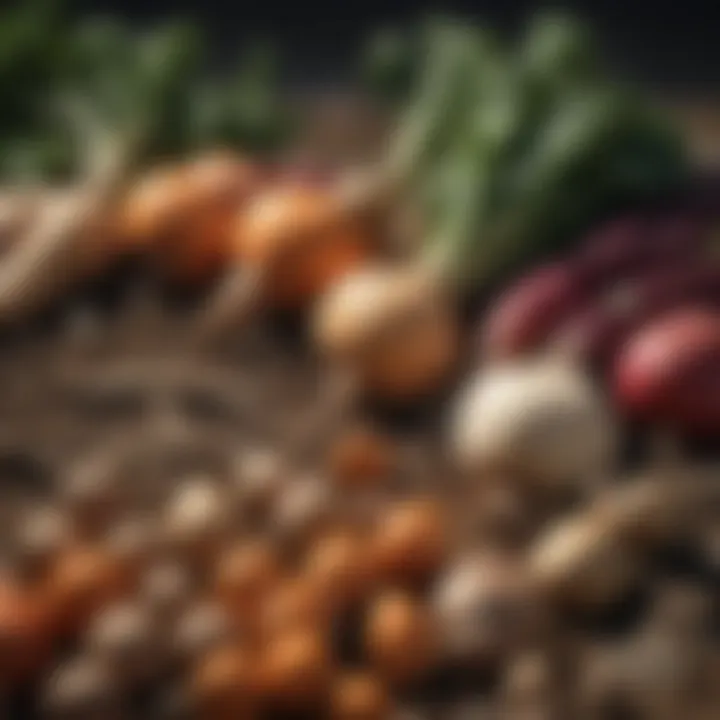Understanding Roots RV: Insights into Root Vegetables


Intro
The exploration of Root Vegetables, commonly referred to as Roots RV, is both necessary and timely as we address the evolving challenges in sustainable agriculture. This exploration uncovers several facets of Root RV that hold major significance for farmers and enthusiast alike. Understanding the cultivation techniques, nutritional advantages, and environmental impacts associated with these crops is crucial for those invested in agricultural practices.
Key Concepts and Terminology
Basic Definitions
Root vegetables are underground parts of plants that are consumed by humans and animals. Common examples include carrots, turnips, and potatoes. These plants accumulate nutrients and energy in their roots, making them valuable food sources. The term "Roots RV" encompasses all varieties of cultivated root vegetables. Various factors influence their growth, including soil quality, weather conditions, and farming techniques.
Historical Context
The consumption of root vegetables dates back thousands of years. Many ancient civilizations relied on them as primary food sources. For instance, the ancient Egyptians cultivated onions and garlic while the Chinese cultivated radishes. Over time, modern agriculture has transformed the cultivation of these crops, incorporating scientific knowledge into traditional practices. This historical framework helps illustrate how integral root vegetables are to both human diets and farming systems.
Recent Innovations and Trends
Technological Advancements
Recent technological advancements are making a significant impact in the cultivation of root vegetables. Precision agriculture incorporates techniques such as GPS-guided equipment and soil sensors to optimize planting resources. These technologies help in monitoring soil moisture levels, enhancing yield predictability and consequently improving overall farm productivity.
Sustainable Practices
Sustainability is increasingly important in modern farming. Innovative practices, such as crop rotation and organic farming, are adopted to maintain soil health. Such methods enhance biodiversity and reduce the need for chemical fertilizers. More farmers are focusing on sustainable practices to improve food security while minimizing environmental damage.
Practical Applications and Techniques
Step-by-step Guides
To cultivate root vegetables successfully, farmers must consider several important steps:
- Soil Preparation: Test the soil for pH and nutrient content. Amend as necessary to achieve optimal growing conditions.
- Planting: Choose a variety suited for the region. Follow planting depth guidelines based on vegetable type.
- Irrigation: Ensure proper watering technique to avoid overwatering, which can rot the roots.
- Pest Management: Monitor for pests and diseases, using integrated pest management strategies to protect crops without harmful chemicals.
Case Studies
Analyzing successful Root RV farming initiatives can provide valuable insights. Numerous agricultural co-operatives around the world have implemented sustainable growing techniques. For example, farms using biodynamic practices have shown increases in yield and soil health. Sharing such case studies encourage others to explore similar methods and heightens awareness about the importance of sustainability in agriculture.
The focus on Root RV not only supports local economies but also contributes to healthier diets and ecosystems.
Prologue to Roots RV
The study of Roots RV holds significant importance within the agricultural discourse. Root vegetables form a vital segment of various agricultural practices globally. Their ability to provide sustenance, nutritional value, and economic benefits makes them essential for farmers and consumers alike. This article aims to explore every aspect of Roots RV, from cultivation to consumption.
Defining Roots RV
Roots RV refers specifically to root vegetables, the edible parts of certain plants that grow underground. These vegetables include, but are not limited to, carrots, beets, turnips, radishes, and sweet potatoes. Each type possesses unique characteristics, flavors, and uses. Understanding the precise definition aids in the proper identification and classification of these vital crops. Moreover, this understanding enables farmers to make informed decisions regarding cultivation and marketing strategies.
Historical Context
The history of root vegetables stretches back millennia. Ancient civilizations in regions such as the Mediterranean and Asia recognized the value of these crops. Evidence shows that root vegetables were a staple in diets of early humans. They were often cultivated for their resilience, providing food during harsher climates. Over time, specific varieties gained prominence due to their adaptability and nutritional benefits. The historical exploration of Roots RV is crucial for recognizing the methods and innovations that have shaped current agricultural practices.
Importance in Agriculture
Root vegetables play an indispensable role in agriculture. They are often cultivated in diverse climates and soils, making them versatile crops suitable for various farming conditions. Additionally, these vegetables contribute to soil health through their growth patterns and nutrient uptake processes. They often require fewer resources than other crops, making them a sustainable choice in agriculture. Their popularity continues to grow in markets, reflecting increasing awareness of healthy diets. As consumers demand more nutritious options, the relevance of Roots RV in modern agriculture only intensifies.
"Root vegetables are often overlooked but serve critical roles in our diets and agricultural systems."
Understanding the underlying principles of Root RV reinforces its value to agriculture farmers and enthusiasts, fostering informed practices within the community.
Types of Root Vegetables
The term "Types of Root Vegetables" encompasses a vast range of plant species that play a critical role in food systems across the globe. These vegetables grow underground and store nutrients. Their significance extends beyond nutritional value to encompass economic and cultural aspects as well. Understanding the varieties and their characteristics benefits both producers and consumers, aiding in informed agricultural practices and dietary choices.
Common Root Varieties
In the world of agriculture, certain root vegetables are well-known for their widespread cultivation and consumption. Common examples include:
- Carrots: Often recognized by their orange color, carrots are rich in beta-carotene, vital for vision and immune health.
- Beets: These vegetables come in various colors and are known for their vibrant, sweet flavor and high fiber content.
- Radishes: With a peppery taste, radishes are favored for salads and quick growing times.
- Potatoes: A staple in many diets, potatoes are versatile and rich in carbohydrates.
These common varieties are often the first choice for farmers due to their market demand and ease of cultivation. The market for these root vegetables is dynamic, driven by consumer preferences and seasonal availability. Understanding market trends can help farmers maximize their yields and profits.
Less Known Root Species
Aside from the common varieties, there are less known root species that deserve attention. These include:
- Salsify: Often called the oyster plant, it has a unique flavor that resembles seafood, making it a delicacy in some dishes.
- Tiger Nuts: A tuber that is technically not a nut but has become popular due to its high fiber and nutrient content. It is used in various health foods.
- Celeriac: Known for its distinctive celery flavor, this root vegetable is often overlooked but can bring unique taste to many recipes.
These lesser-known species often contain similar, if not better, nutritional benefits and can introduce variety into diets. Promoting such species could also help diversify farming practices and reduce reliance on staple crops.
Nutritional Profiles
Root vegetables are nutrient-dense, offering an array of vitamins and minerals crucial for health. Their nutritional profiles vary significantly:
- Carrots: High in vitamin A and antioxidants, aiding in eye health.
- Potatoes: A good source of vitamin C and potassium, providing energy.
- Beets: Rich in folate, manganese, and nitrates, beneficial for cardiovascular health.
Incorporating a mix of these vegetables into diets can enhance overall nutrition. Different roots provide not only essential vitamins and minerals but also dietary fiber, promoting digestive health. This understanding is critical for agriculture farmers and enthusiasts developing nutrition-focused cultivation strategies.
Nutritional diversity in root vegetables supports healthy diets and can play a role in sustainable agricultural practices, fostering biodiversity in the farming ecosystem.


Cultivation Techniques for Root Vegetables
Cultivation techniques for root vegetables are essential to understand for anyone involved in agriculture. The success of growing these vegetables relies heavily on appropriate methods tailored to the needs of the plants. This section will cover three key aspects: soil requirements, planting methods, and harvesting processes. Each of these topics plays a critical role in achieving optimal yields while maintaining environmental sustainability.
Soil Requirements
When it comes to cultivating root vegetables, the soil serves as the foundation for growth. The right soil composition can significantly affect plant health and vegetable quality.
- Texture: Loamy soil, which combines sand, silt, and clay, is ideal. This texture allows for proper drainage while retaining enough moisture.
- pH Level: Most root vegetables prefer a slightly acidic to neutral pH level, typically between 6.0 and 7.0. Testing the soil's pH can help in making necessary adjustments using lime or sulfur.
- Nutrient Content: Root vegetables require soil rich in organic matter. Adding compost or well-rotted manure can boost nutrient availability.
- Drainage: It is crucial to have good drainage to prevent waterlogging, which can lead to root rot.
In summary, ensuring optimal soil conditions will lay the groundwork for healthy root development and robust crops.
Planting Methods
The way root vegetables are planted can influence growth patterns and yield. Different techniques are suited to varying types of root crops, such as carrots, potatoes, and beets.
- Seed Selection: Quality seeds are vital. Choose certified seeds to minimize diseases.
- Direct Seeding: This method is suitable for many root vegetables like radishes and carrots. Seeds are sown directly into the soil at the recommended depth.
- Transplanting: Some root crops, like onions, benefit from this method. Start seeds indoors and transplant seedlings to the field. This approach can give plants a head start in the growing season.
- Spacing: Proper spacing between seeds is important for growth. Crowded plants can lead to poor root development and reduced yields. A good rule of thumb is to follow the recommended spacing based on the specific vegetable.
Utilizing effective planting methods equips farmers to maximize their harvest.
Harvesting Processes
Harvesting is a critical stage in root vegetable cultivation that can influence quality and storage ability. Timing and technique are vital considerations to maximize yield.
- Timing: Each root vegetable has a specific maturity date. Monitoring growth and checking for readiness—based on size and season—is crucial.
- Tools: Use proper tools like garden forks or spades. These tools can help remove root vegetables with minimal damage.
- Handling: After harvesting, handle root vegetables carefully. Bruises can lead to spoilage, affecting both appearance and taste.
- Storage: For short-term storage, keep the vegetables in a cool, dark place. For long-term, refrigeration or controlled environment storage can prolong shelf life.
Effective harvesting processes ensure the preservation of quality and extend the usability of root vegetables.
Understanding the cultivation techniques for root vegetables not only fosters better practices but enhances overall productivity for growers.
By focusing on soil requirements, planting methods, and harvesting techniques, farmers can achieve a successful harvest of root vegetables. These practices play a pivotal role in cultivating crops that are nutritionally rich and economically viable.
The Role of Root Partnerships
Understanding the role of root partnerships is essential in agriculture. Collaborative relationships between different plants not only enhance growth but also contribute to soil health. These partnerships can increase crop yield and resilience, which are critical for sustainable farming. The function of these interactions cannot be stressed enough, especially regarding the interconnected aspects of companion planting, crop rotation, and soil microbial dynamics.
Companion Planting
Companion planting involves growing different types of plants close together for mutual benefits. Some combinations support each other in several ways:
- Pest Control: Certain plants can repel harmful insects. For instance, marigolds are known to deter nematodes and other pests.
- Nutrient Sharing: Some root vegetables, like carrots, can grow alongside beans, which fix nitrogen in the soil. This enhances soil fertility.
- Improved Growth: Companion plants can provide shade or support, helping root vegetables to thrive. Corn, for example, offers a grow medium for climbing beans.
It is useful to research compatible plants to foster these partnerships effectively. They can lead to healthier crops and reduced need for chemical fertilizers and pesticides.
Crop Rotation Strategies
Crop rotation is another critical practice in root vegetable farming. It involves changing the types of crops grown in a particular area over time. This method offers several benefits:
- Soil Health Improvement: Alternating root vegetables with other crops helps maintain nutrient balance in the soil. Different plants have varied nutrient needs, which can prevent soil depletion.
- Disease Management: Rotating crops reduces the risk of soil-borne diseases. Since pests are often attracted to specific plants, changing crops can disrupt their lifecycle.
- Enhanced Biodiversity: Varied plant species encourage a diverse ecosystem in the farm, promoting resilience against environmental changes.
Implementing a strategic crop rotation plan is essential to maximize soil and plant health over years.
Soil Microbial Interactions
The interactions between soil and microorganisms play a vital role in the health of root vegetables. A diverse microbial community is essential for nutrient cycling and plant growth. Key points include:
- Nutrient Availability: Soil microbes help break down organic matter, making nutrients available to plants. They play a role in processes like nitrogen fixation and decomposition.
- Root Health: Some microbes, such as mycorrhizal fungi, form beneficial relationships with root systems. This symbiosis can enhance moisture and nutrient uptake.
- Disease Suppression: A healthy microbial community can suppress soil pathogens, reducing the likelihood of diseases in root vegetables.
Investing in practices that promote microbial health is essential for sustainable farming. This can include cover cropping, reduced tillage, and organic matter addition.
Sustainable Practices in Root Vegetable Farming
Sustainable practices in root vegetable farming are critical for ensuring the longevity and health of agricultural ecosystems. These practices aim to minimize environmental impact while maximizing efficiency and crop yield. The focus on sustainability is vital in addressing current challenges faced in agriculture, including climate change, resource degradation, and food security. Implementing sustainable methods is not merely beneficial; it is becoming increasingly essential for farmers to adapt to changing market demands and environmental conditions.
Organic Farming Techniques
Organic farming is a cornerstone of sustainable agriculture. It relies on natural processes and cycles to maintain soil fertility and ecosystem balance. Farmers use organic methods to grow root vegetables by eschewing synthetic fertilizers and pesticides. Instead, they leverage composting, crop rotation, and mulching to build soil health. These techniques foster biodiversity, leading to more resilient farming systems.
Additionally, organic farming enhances the nutritional value of produce. Studies indicate that organic root vegetables often have higher levels of antioxidants and beneficial compounds. Understanding how to implement organic farming can directly impact consumer health and satisfaction, creating a niche market for farmers who prioritize quality.
Pesticide Alternatives
The negative impacts of chemical pesticides on health and the environment are well-documented. To combat pests while adhering to sustainable principles, farmers can explore several alternatives. Integrated Pest Management (IPM) is one such approach. It combines biological control, habitat manipulation, and resistant crop varieties to manage pest populations effectively.
Furthermore, using natural pesticides like neem oil or insecticidal soap has gained popularity among root vegetable producers. These substances tend to have minimal impact on the environment compared to their synthetic counterparts. Educating farmers about these alternatives is crucial for reducing reliance on harmful chemicals.
Water Conservation Methods
Water conservation is another vital concern in enhancing sustainability in root vegetable farming. Efficient water usage not only helps preserve this precious resource but also ensures crops receive adequate moisture for optimal growth. Techniques such as drip irrigation, which delivers water directly to the plant's root zone, can significantly reduce water waste.
Rainwater harvesting is also an innovative method farmers can adopt. This practice involves collecting rainwater for irrigation, reducing dependence on municipal or groundwater sources. Crop selection plays a role as well; drought-resistant varieties can help minimize water needs while maintaining yield.
Effective water conservation strategies are essential in safeguarding agricultural productivity as climate conditions grow more unpredictable.
In summary, sustainable practices in root vegetable farming are integral for future-proofing agriculture. By employing organic techniques, exploring non-chemical pest management, and prioritizing water conservation, farmers can not only enhance their economic viability but also contribute positively to the environment. These practices create a robust foundation for sustainable agriculture, ensuring healthy crops and a healthier planet.
The Economic Impact of Roots RV
The economic significance of Roots RV is a multidimensional topic that encompasses various aspects including market demand, cost analysis, and potential export markets. Understanding these elements is crucial not only for farmers but also for policymakers, investors, and educators in the agriculture sector. The exploration of economic impacts can lead to more informed decisions, increased profitability, and sustainable agricultural practices.


Market Demand Analysis
Analyzing market demand for root vegetables reveals trends that can have a direct impact on agricultural production. Consumer preferences are shifting towards more nutritious and diverse diets, creating opportunities for root vegetables like carrots, beets, and sweet potatoes.
- Growth Trends: The worldwide preference for organic produce has led to a surge in demand for root vegetables. This growth is particularly notable in developed nations where health consciousness is rising.
- Regional Variations: Different regions show varied preferences based on culinary traditions. For instance, cassava is widely consumed in Africa, while radishes have a more significant presence in Asian cuisines.
- Seasonal Fluctuations: The demand can fluctuate with seasons, especially for root vegetables that can be stored for long periods. Understanding these trends helps farmers decide what to plant at what time, optimizing yield and reducing waste.
Cost-Benefit Considerations
Evaluating the cost-benefit analysis is pivotal for root vegetable producers. This assessment includes production costs, labor, and potential profits.
- Production Costs: Factors such as soil preparation, seeds, fertilizers, and irrigation significantly contribute to initial investments. Farmers must account for these when pricing their products.
- Labor Expenses: Harvesting root vegetables often requires substantial manual labor. This cost can be offset by investing in tools or machinery designed to efficiently handle root crops. However, upfront costs for equipment can be high.
- Profit Margins: The profit from selling root vegetables can be substantial if market prices remain favorable. When farmers understand both their fixed and variable costs, they can make better pricing decisions that maximize their profitability.
Export Opportunities
The global marketplace presents numerous opportunities for the export of root vegetables. As countries aim to diversify their agriculture and improve food security, root vegetables are positioned well for international trade.
- Emerging Markets: Countries such as India and Vietnam are increasing their production capabilities and looking for export opportunities. This demand is strong particularly for exotic varieties.
- Export Regulations: Understanding the legal regulations and standards in different countries is vital. Compliance will allow root vegetable producers to access international markets without interruption.
- Supply Chain Management: Efficiently managing the supply chain can enhance competitiveness. This involves logistics, partnerships with distributors, and understanding local market needs to ensure that the right products reach the right locations.
"The economic dimension of roots RV not only contributes to financial viability but also supports food security and sustainable practices in agriculture."
Innovations in Root Vegetable Farming
Innovations in root vegetable farming are critical to advancing agricultural practices and enhancing sustainability. In an era marked by climate challenges and increasing food demands, adopting modern techniques becomes essential. Such innovations not only improve crop yields but also contribute to environmental stewardship. Here, we explore three main areas of focus: technological advances, research developments, and future trends.
Technological Advances
The integration of technology in farming has revolutionized how root vegetables are cultivated. Precision agriculture is a notable example that employs GPS systems and drones for monitoring crops. These technologies allow farmers to assess soil health and moisture levels accurately.
Benefits of Technological Advances:
- Increased Efficiency: Automation in planting and harvesting reduces labor costs and time.
- Data-Driven Decisions: Access to real-time data aids in informed decision-making, resulting in optimized resource usage.
- Better Pest Control: Use of technology helps identify pest populations early, reducing chemical usage.
Research Developments
Research plays a significant role in improving root vegetable varieties. Developing new strains that are resistant to diseases and pests can lead to more robust crops. Universities and agricultural institutes are actively engaged in this research. They explore genetic variations and environmental adaptations.
Some areas of research include:
- Genetic engineering for enhanced nutritional content.
- Climate-resilient root vegetable varieties.
- Sustainable practices that utilize less water and energy.
"The future of agriculture will depend on how well we adopt and adapt to new research findings, especially in a changing climate."
Future Trends
As we look ahead, several trends are shaping the future of root vegetable farming. One such trend is the increasing importance of urban agriculture. More people are turning to home gardening due to space limitations and interest in fresh produce.
In addition, regenerative agriculture is gaining momentum. This approach emphasizes restoring soil health through crop rotation and polyculture. The expected outcomes of these trends include:
- Enhanced food security through local produce.
- Reduction in carbon footprints related to food transportation.
- Community engagement in agriculture.
Challenges Facing Root Vegetable Producers
Root vegetable production is a critical aspect of agricultural sustainability and food security. However, producers are increasingly confronted with a range of challenges that threaten both crop yields and economic viability. Understanding these challenges is essential for anyone involved in agriculture, particularly those focused on cultivating root vegetables. The pressing issues include climate change effects, pest management, and soil degradation concerns, each presenting unique obstacles and necessitating adaptive strategies.
Climate Change Effects
Climate change has emerged as a dominant force shaping agricultural practices. Root vegetable producers are particularly vulnerable due to their reliance on specific soil and weather conditions. Extreme weather events, such as droughts and floods, can devastate root crops, leading to significant yield loss. Furthermore, temperature fluctuations can affect germination rates and the overall growth cycle of these plants.
The changing climate not only disrupts traditional farming schedules but also intensifies the prevalence of pests and diseases that thrive under warmer conditions. As a response to these challenges, producers must consider modifying their cultivation strategies. This can include selecting more resilient varieties, implementing innovative irrigation techniques, and adopting crop rotation practices to improve soil health.
"Adapting to climate change is no longer optional for root vegetable producers; it is a necessity to ensure long-term sustainability."
Pest Management Issues
Pest management is a longstanding challenge in agriculture. Root vegetable crops, including carrots, beets, and potatoes, attract various pests that can undermine production. Common pests, such as nematodes and aphids, pose significant threats that require vigilant management. Chemical pesticides, while effective, often lead to concerns about environmental impact and human health.
Integrated Pest Management (IPM) strategies are gaining traction among producers. This approach combines biological, cultural, and mechanical methods to manage pests with minimal chemical use. By diversifying crops and promoting natural predators, farmers can manage outbreaks more sustainably. Additionally, advanced technologies such as pest-resistant varieties and precision agriculture can enhance pest control efforts.
Soil Degradation Concerns
Soil health is foundational to successful root vegetable production. However, practices like monoculture, overuse of chemical fertilizers, and poor land management can lead to soil degradation. Compacted or depleted soils hinder root growth and reduce nutrient availability, directly negatively impacting crop yields.
To counter soil degradation, producers can implement regenerative agriculture practices. Techniques such as cover cropping, reduced tillage, and organic amendments like compost improve soil structure and fertility. By prioritizing soil health, farmers can enhance their resilience to other challenges, such as those posed by climate change and pest pressures.
In summary, the hurdles facing root vegetable producers are multifaceted and interlinked. Addressing the effects of climate change, refining pest management strategies, and combating soil degradation are essential steps towards a sustainable future in root vegetable farming. Understanding these challenges allows producers to develop informed strategies that can safeguard their livelihood and contribute positively to the agricultural landscape.
Nutritional Benefits of Roots RV
The exploration of the nutritional benefits of Roots RV uncovers the essential components that make root vegetables a valuable part of the human diet. These vegetables are not just agricultural products; they hold significant health benefits that contribute to overall well-being. Understanding these benefits helps farmers and consumers make informed choices about their diet and cultivation practices.
Essential Vitamins and Minerals
Root vegetables are often rich sources of essential vitamins and minerals. Carrots, for instance, are known for their high content of Vitamin A, which plays a crucial role in maintaining good vision and a healthy immune system. Beets provide significant levels of folate, vital for DNA synthesis and repair. Additionally, many root vegetables contain potassium, which is important for heart health and regulating blood pressure.
Including a diverse range of root vegetables in the diet ensures that one can benefit from a variety of these nutrients, supporting different bodily functions. The availability of such minerals and vitamins in root vegetables is often higher than in many other fruit and vegetable forms.
Dietary Fiber Importance


Dietary fiber is another crucial aspect of root vegetables. These fibers contribute to digestive health by promoting regular bowel movements and preventing constipation. Root vegetables such as sweet potatoes and turnips are high in both soluble and insoluble fiber.
- Soluble fiber helps lower cholesterol levels and stabilizes blood sugar levels.
- Insoluble fiber adds bulk to the diet and assists in the movement of food through the digestive tract.
Incorporating these root vegetables into daily meals can enhance overall fiber intake, contributing to improved gastrointestinal health. This is especially important in many modern diets, which can be low in fiber due to a lack of whole fruits and vegetables.
Role in Disease Prevention
The potential role of root vegetables in disease prevention cannot be overlooked. Studies have suggested that their high antioxidant content can combat oxidative stress in the body. This is crucial in reducing inflammation, which is linked to various chronic diseases such as heart disease and cancer.
Moreover, root vegetables often contain compounds such as beta-carotene and anthocyanins, known for their protective properties against certain diseases. For example:
- Beta-carotene, found in carrots, may lower the risk of lung cancer when consumed in adequate amounts.
- Antioxidants in beets may boost heart health by improving blood flow and reducing blood pressure.
In summary, the nutritional benefits of Roots RV are extensive. From essential vitamins and minerals to dietary fiber and disease prevention, root vegetables present various advantages that can enhance not only agricultural productivity but also individual health. The consumption of these vegetables can foster improved health outcomes, making them an integral part of sustainable diets.
Culinary Applications of Roots RV
Culinary applications of root vegetables play a crucial role in the broader context of food preparation and dietary habits. In many cultures, these vegetables are not just staples; they are key ingredients that embody flavors, nutritional value, and culinary traditions. Understanding how to prepare these vegetables effectively enhances their taste and preserves their nutritional integrity. This section discusses various aspects related to the culinary applications of root vegetables, including preparation methods, popular dishes, and preservation techniques.
Preparing Root Vegetables
Preparing root vegetables is a fundamental step for any culinary enthusiast. Whether it is carrots, turnips, or beets, ensuring that they are properly cleaned and cut can greatly affect the outcome of a dish. The first step usually involves washing them thoroughly to remove dirt. After this, peeling may be necessary, although some root vegetables, like potatoes, can be cooked with their skins on to maximize fiber content.
Chopping methods can vary. For instance, dicing is often preferred for soups, while julienned vegetables can be used in stir-fries. Cooking methods also vary, ranging from steaming and boiling to roasting and frying. The choice of preparation impacts both the flavor and texture. Choosing the right method based on the type of root vegetable is crucial for achieving the desired culinary outcome.
Popular Root Dishes
Root vegetables are widely celebrated in global cuisines, resulting in a myriad of popular dishes. Some classic examples include:
- Borscht: A beet-based soup commonly found in Eastern European cuisine, borscht is known for its vibrant color and unique flavor. It can be served hot or cold, often garnished with sour cream.
- Colcannon: This traditional Irish dish combines mashed potatoes with cabbage or kale, offering a comforting and hearty meal.
- Ratatouille: A French dish that includes various root vegetables, like eggplant and zucchini, cooked together with herbs. It highlights the versatility of root vegetables in a mixed dish.
- Sweet Potato Casserole: A favorite in American households, especially during the holidays, this dish often includes marshmallows or pecans, showcasing the sweet flavor of root vegetables.
Such dishes not only display the flavors of root vegetables but also cater to a wide range of dietary preferences.
Preservation Methods
To maintain the freshness and nutritional value of root vegetables, proper preservation methods are essential. Here are some effective ways to preserve these ingredients:
- Refrigeration: Most root vegetables can be stored in a fridge for extended freshness. Using perforated plastic bags can help regulate moisture levels.
- Freezing: Chopping and blanching root vegetables before freezing preserves their color and nutrient content. This method is particularly useful for bulk storage.
- Canning: Some root vegetables, such as carrots and beets, can be preserved through canning. However, this method requires proper technique to ensure safety and quality.
"Effective preservation is key to maximizing the culinary potential of root vegetables. Properly stored, they can offer great flavor and nutrition year-round."
- Fermentation: This method not only preserves but also enhances the flavors. Fermented root vegetables can offer a tangy boost to meals.
Cultural Significance of Root Vegetables
Root vegetables have played a pivotal role in the cultural narratives of various societies throughout history. These underground staples are not merely food items; they are intertwined with traditions, rituals, and economic practices across the globe. Their significance extends beyond their nutritional benefits, as they embody the cultural identities and agricultural practices of numerous communities.
Roots RV in Global Cuisines
In different parts of the world, root vegetables are celebrated in distinct culinary traditions. For instance, in Asian cuisines, vegetables like daikon and lotus root are integral to many dishes, prized for their unique textures and flavors. In Europe, the potato has transcended its humble origins to become a critical ingredient in traditional dishes ranging from shepherd's pie to pierogi. Each culture utilizes root vegetables in ways that reflect local tastes, climates, and agricultural practices, showcasing the adaptability of these foods.
Moreover, root vegetables often serve as symbols of resilience and sustenance. For example, during challenging economic times, many cultures have turned to root crops as a source of nourishment. This reliance reinforces their status as not just food, but also a cultural emblem of survival and adaptability.
Symbolism and Traditions
Root vegetables carry profound symbolism that reflects the values of the societies that cultivate them. In many cultures, they symbolize fertility, wealth, and sustenance. For instance, in some traditions, the first harvest of root vegetables is celebrated with festivals, marking a time of abundance and gratitude.
In various indigenous cultures, root vegetables often play a role in spiritual rituals. They are sometimes used as offerings, believed to nourish both the land and spirits. Such practices highlight the deep respect for the earth and its produce, effectively connecting communities with their agricultural roots.
Furthermore, the seasonal cycle of planting and harvesting is often marked by community gatherings. These events foster a sense of unity among local farmers and families, who share knowledge and experience, thereby preserving traditional farming methods and enhancing food security.
Local Growing Practices
Local growing practices of root vegetables reflect both the adaptability and sustainability of these crops. In many regions, farmers employ traditional methods, such as crop rotation and companion planting, to maintain soil health and maximize yields. These practices are not only beneficial for the environment but also enhance the flavor and nutritional value of the vegetables.
Regions known for specific root vegetables, such as sweet potatoes in the southern United States or turnips in Northern Europe, often have distinct growing methods developed over generations. These practices are informed by local climate and soil conditions, demonstrating the intimate relationship between culture and agriculture.
"The cultivation of root vegetables is more than planting seeds; it nurtures traditions and sustains lives."
Future Prospects of Roots RV
The future of Roots RV is a critical topic for understanding how agriculture can evolve to meet changing demands. This section discusses key aspects such as advancements in biotechnology, the role of climate resilience, and urban agriculture potential. These elements are essential for farmers and agricultural enthusiasts, as they highlight innovative strategies that can improve yield, sustainability, and food security.
Advancements in Biotechnology
Biotechnology has the potential to transform root vegetable farming significantly. By utilizing genetic modifications and advanced breeding techniques, farmers can enhance resistance to pests and diseases. This means less reliance on chemical pesticides, providing an eco-friendly way to cultivate crops. Furthermore, biotechnology can lead to improved nutritional profiles of root vegetables. Farmers can develop varieties that have higher levels of essential vitamins and minerals, contributing to better health outcomes.
For instance, scientists are working on developing drought-resistant root crops. These innovations will help farmers manage the supply of food during periods of low rainfall. In addition, the ability to cultivate plants faster through biotechnology allows for greater flexibility in crop rotation. Therefore, biotechnology not only promises a greater yield but also contributes to sustainable agricultural practices that are increasingly necessary in today's world.
Role in Climate Resilience
The impact of climate change is a pressing issue for agricultural sectors globally. Roots RV can play an important role in ensuring food security in the face of these changes. Root vegetables are generally hardy, requiring less water than many other crops, making them well-suited for arid environments. By cultivating root vegetables, farmers can adapt to varying climatic conditions, helping mitigate the effects of climate change.
Moreover, planting these crops enhances soil health and aids in carbon sequestration. Healthier soils lead to better water retention and improved nutrient availability to plants. Farmers adopting sustainable practices often report enhanced yield and stability, reinforcing the significance of root vegetables in sustainable farming strategies.
"Utilizing root vegetables helps not just in adapting to climate but also in restoring ecosystems."
Potential for Urban Agriculture
Urban agriculture is gaining traction as cities look for local solutions to food supply challenges. Roots RV holds promise in urban settings due to their minimal spatial requirements. Whether it is small gardens or container farming, root vegetables can thrive in these spaces. This adaptability allows city dwellers to grow their fresh produce, ultimately reducing the carbon footprint associated with transporting food.
Furthermore, investing in urban agriculture can increase community engagement and knowledge sharing about sustainable practices. Programs that promote local cultivation of root vegetables often lead to improved food security. The easy growing conditions and diverse culinary applications make root vegetables attractive to urban gardeners.
In summary, the future prospects of Roots RV encompass vital advancements in technology, adaptations to climate changes, and opportunities within urban agriculture. This topic, being central to agricultural innovation, serves as a foundation for sustainable practices that can help secure food for the growing global population.















